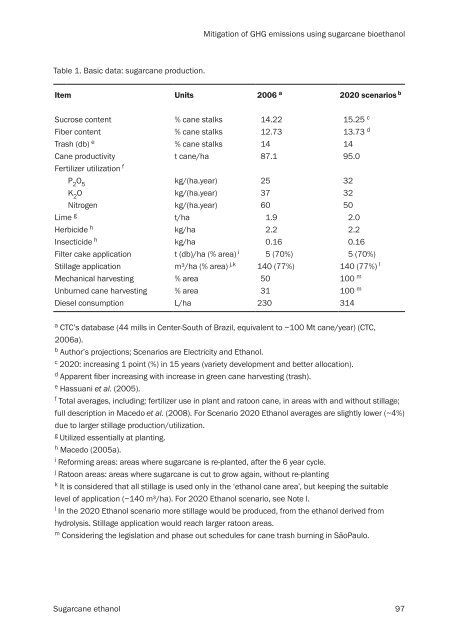Sugarcane ethanol: Contributions to climate change - BAFF
Sugarcane ethanol: Contributions to climate change - BAFF
Sugarcane ethanol: Contributions to climate change - BAFF
Create successful ePaper yourself
Turn your PDF publications into a flip-book with our unique Google optimized e-Paper software.
Table 1. Basic data: sugarcane production.<br />
Mitigation of GHG emissions using sugarcane bio<strong>ethanol</strong><br />
Item Units 2006 a 2020 scenarios b<br />
Sucrose content % cane stalks 14.22 15.25 c<br />
Fiber content % cane stalks 12.73 13.73 d<br />
Trash (db) e % cane stalks 14 14<br />
Cane productivity<br />
Fertilizer utilization<br />
t cane/ha 87.1 95.0<br />
f<br />
P2O5 kg/(ha.year) 25 32<br />
K2O kg/(ha.year) 37 32<br />
Nitrogen kg/(ha.year) 60 50<br />
Lime g t/ha 1.9 2.0<br />
Herbicide h kg/ha 2.2 2.2<br />
Insecticide h kg/ha 0.16 0.16<br />
Filter cake application t (db)/ha (% area) i 5 (70%) 5 (70%)<br />
Stillage application m³/ha (% area) j,k 140 (77%) 140 (77%) l<br />
Mechanical harvesting % area 50 100 m<br />
Unburned cane harvesting % area 31 100 m<br />
Diesel consumption L/ha 230 314<br />
a CTC’s database (44 mills in Center-South of Brazil, equivalent <strong>to</strong> ~100 Mt cane/year) (CTC,<br />
2006a).<br />
b Author’s projections; Scenarios are Electricity and Ethanol.<br />
c 2020: increasing 1 point (%) in 15 years (variety development and better allocation).<br />
d Apparent fiber increasing with increase in green cane harvesting (trash).<br />
e Hassuani et al. (2005).<br />
f Total averages, including: fertilizer use in plant and ra<strong>to</strong>on cane, in areas with and without stillage;<br />
full description in Macedo et al. (2008). For Scenario 2020 Ethanol averages are slightly lower (~4%)<br />
due <strong>to</strong> larger stillage production/utilization.<br />
g Utilized essentially at planting.<br />
h Macedo (2005a).<br />
i Reforming areas: areas where sugarcane is re-planted, after the 6 year cycle.<br />
j Ra<strong>to</strong>on areas: areas where sugarcane is cut <strong>to</strong> grow again, without re-planting<br />
k It is considered that all stillage is used only in the ‘<strong>ethanol</strong> cane area’, but keeping the suitable<br />
level of application (~140 m³/ha). For 2020 Ethanol scenario, see Note l.<br />
l In the 2020 Ethanol scenario more stillage would be produced, from the <strong>ethanol</strong> derived from<br />
hydrolysis. Stillage application would reach larger ra<strong>to</strong>on areas.<br />
m Considering the legislation and phase out schedules for cane trash burning in SãoPaulo.<br />
<strong>Sugarcane</strong> <strong>ethanol</strong> 97












